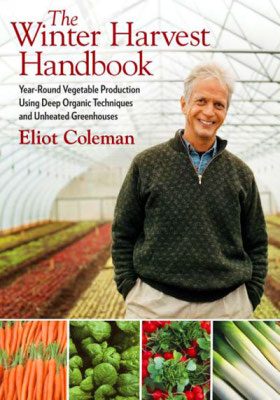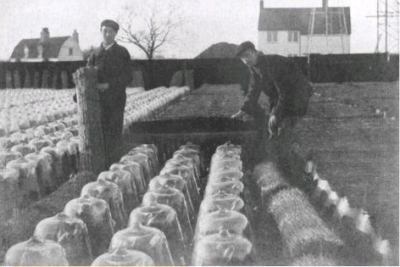
Winter Harvest Handbook
 In 1968, Eliot Coleman (quite
literally) bought Helen and Scott
Nearings'
back 40 acres and started farming. His farm is on the
coast of Maine --- zone 5 --- where many people think growing
conditions are tough for even producing a summer crop. But
Coleman didn't want to think so small. Instead, he dreamed of
developing a low tech and economical way to harvest fresh vegetables
year round. The
Winter Harvest Handbook
is a beautifully illustrated and clearly written guide that sums up
forty years of gardening experience and tells precisely how to harvest
salad greens and a few other crops all winter long.
In 1968, Eliot Coleman (quite
literally) bought Helen and Scott
Nearings'
back 40 acres and started farming. His farm is on the
coast of Maine --- zone 5 --- where many people think growing
conditions are tough for even producing a summer crop. But
Coleman didn't want to think so small. Instead, he dreamed of
developing a low tech and economical way to harvest fresh vegetables
year round. The
Winter Harvest Handbook
is a beautifully illustrated and clearly written guide that sums up
forty years of gardening experience and tells precisely how to harvest
salad greens and a few other crops all winter long.
Coleman started his
journey by looking into the past. 150 years ago, Parisian farmers
(maraichers)
grew all of the city's vegetables and even exported some to England
using just 6% of the city's land area as growing space. Their
highly intensive
gardens depended on copious amounts of horse manure from the city
stables --- sometimes as much as 400 tons per acre. (For the sake
of comparison, Lee
Reich's mulch campaign,
which I thought was beyond my ability to achieve, used only about 90
tons of organic matter per acre,  assuming
a conversion rate of about 1350 pounds per cubic yard.) This
French manure was used fresh as the heat source in hotbeds for winter
growing, with panes of glass over the top and then a mat of straw for
additional night-time insulation as needed. They also used
thousands of glass cloches (bottomless jars) to protect individual
plants.
assuming
a conversion rate of about 1350 pounds per cubic yard.) This
French manure was used fresh as the heat source in hotbeds for winter
growing, with panes of glass over the top and then a mat of straw for
additional night-time insulation as needed. They also used
thousands of glass cloches (bottomless jars) to protect individual
plants.
The French intensive
gardening system was clearly successful, but it
was also hugely labor-intensive. The hotbeds and cloches could
overheat on sunny days, so farmers would spend hours walking down the
rows and manually propping them open in the morning, then closing each
one back up as the sun fell at night. Modern winter-growers have
replaced all of this labor with high tech thermostats and self-opening
vents and fans, but Coleman wanted to find a system somewhere in the
middle. This week's lunchtime series details his method that
combines the simplicity of the French system with enough modern
conveniences to let you grow winter greens without quite so much
back-breaking labor.
| This post is part of our Winter Harvest Handbook lunchtime series.
Read all of the entries: |
Want more in-depth information? Browse through our books.
Or explore more posts by date or by subject.
About us: Anna Hess and Mark Hamilton spent over a decade living self-sufficiently in the mountains of Virginia before moving north to start over from scratch in the foothills of Ohio. They've experimented with permaculture, no-till gardening, trailersteading, home-based microbusinesses and much more, writing about their adventures in both blogs and books.
Want to be notified when new comments are posted on this page? Click on the RSS button after you add a comment to subscribe to the comment feed, or simply check the box beside "email replies to me" while writing your comment.
